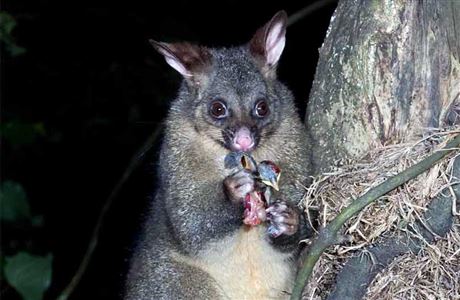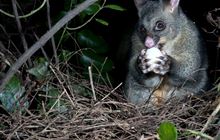DOC and New Zealand Fur Council agreement a win-win – except for possums
Archived content: This media release was accurate on the date of publication.
Introduction
Greater conservation and economic benefits will follow an agreement signed by the Department of Conservation and New Zealand Fur Council today.Image gallery
-
Possum eating chick Image: Nga Manu Images ©
![Possum eating chick. Possum eating chick.]()
-
Possum scavenges at a wood pigeon nest Image: Nga Manu Images ©
![Possum scavenges at a wood pigeon nest. Possum scavenges at a wood pigeon nest.]()
Date: 15 April 2015 Source: Department of Conservation and New Zealand Fur Council
DOC already works with individuals who wish to hunt and trap on conservation land, but this Memorandum of Understanding (MOU) with the collective voice of the possum fur industry will make it easier for Fur Council accredited hunters and trappers across the country to gain access to public conservation land for fur recovery operations.
“We need more possum fur to increase the market size for New Zealand's unique blended Brushtail possum yarns and garments,” says Neil Mackie, chairman of the New Zealand Fur Council.
“Many of the possums in our country are on public conservation land, so the MOU will allow trappers to access more fur, increase the market, and better target ecologically important areas.”
Lou Sanson, Director General of Conservation says: “The agreement is a pragmatic way to broaden the battle against a pest that preys on native wildlife and eats an estimated 21,000 tonnes of bush a night. We have to prioritise our possum control operations on the areas where the forests or wildlife are most vulnerable but there are millions of hectares of bush that we simply can’t get to.
“By encouraging fur trappers into these areas we can deliver results for the taxpayer, the fur industry, and conservation. Our research shows that having trappers knocking down possum numbers in the buffer zones around our own targeted pest control projects can delay possum re-invasion by two to three years.
“DOC spends more than $10 million a year on possum control so any delay in re-invasion will give New Zealanders’ more bang for their buck – as well as precious extra time for our native plants and birds to recover. The fact that New Zealand businesses and local communities will also benefit from enabling more fur recovery operations is the icing on the cake.”
Mackie says there is unfulfilled international market demand for blended Brushtail products.
“Working alongside the Department of Conservation will be an important part of telling overseas consumers how possum fur products are environmentally and ethically sound. We've been delighted with DOC's willingness to work with the trapping industry and look forward to a rewarding and ongoing relationship,” says Mackie.
As well having been seen on the fashion catwalks of Paris, in the increasingly trendy hand-knitting scene, blended Brushtail possum yarns are recognised as a special product he says.
Background
- The New Zealand possum fur industry currently generates retail sales of possum-related garments of $100 million to $150 million per year, with international tourists accounting for 85 percent of total retail sales. The industry employs about 1,500 workers.
- The Brush Tail Possum was introduced to New Zealand from Australia in the 19th century and without any natural predators has rapidly spread through New Zealand’s forests. The imported possum poses a major threat to New Zealand’s indigenous species – they prey on native birds and wildlife and threaten forest canopy.
- DOC uses a range of pest control measures to suppress possum populations in areas of high biodiversity. About 10% of the 8.5 million hectares of conservation land is currently under sustained possum control management using both poisoning and trapping techniques.
Contact
New Zealand Fur Council
Neil Mackie, Chairperson
+64 4 920 5310 or +64 21 670 099
email: neil.mackie@woolyarns.co.nz
Department of Conservation
Rory Newsam
+64 27 295 3809
email: rnewsam@doc.govt.nz



